Horses, magnificent and powerful animals, have roamed the plains and mountains and captivated human attention for centuries. Belonging to the animal kingdom, class Mammalia, and order Perissodactyla, horses have played an integral role in human history, from transportation and agriculture to sports and companionship.
It is hard not to appreciate the vibrant and engaging spirit of the different horses. As you explore below, you will learn more about the enchanting world of horses, discovering their diverse breeds, lifespan, dietary needs, and their suitability for riding and various activities.
Horses encompass a wide range of breeds, each exhibiting unique characteristics, appearances, and temperaments. While the exact number of horse breeds may vary, there are hundreds of recognized breeds worldwide. Let’s explore some of the most common and popular horse breeds.
Five Popular Horse Breeds
The five of the famous horse breeds, known for their distinctive characteristics and wide recognition, are:
- Arabian: Arabian horses are renowned for their elegance, endurance, and distinctive head shape. They are one of the oldest and most influential horse breeds, often associated with the Middle East. Arabians excel in various equestrian disciplines.
- Thoroughbred: Thoroughbreds are famous for their speed and agility. They are best known for horse racing and are the primary breed used in this sport. These horses are sleek, tall, and bred for performance.
- American Quarter Horse: The American Quarter Horse is celebrated for its versatility and ability to sprint short distances. They are widely used in rodeo events, ranch work, and various western riding styles.
- Appaloosa: Appaloosas are known for their striking coat patterns, which can include spots, blankets, and roaning. They are versatile horses, commonly used in both western and English riding.
- Friesian: Friesians are recognized for their powerful, graceful appearance and thick, flowing manes and tails. They are often associated with carriage driving and dressage.
These horse breeds have made a significant impact on the equestrian world, both in terms of their historical significance and their roles in various equine activities. You can scroll down and view some of these and other breeds of horses and see their unique characteristics.
Summary
Horses, with their grace, strength, and remarkable bond with humans, continue to captivate our hearts. From the stunning Appaloosa to the gentle Clydesdale and the swift Thoroughbred, each horse breed possesses unique qualities that make them special. Understanding their diverse breeds, lifespan, dietary requirements, and suitability for different activities allows us to appreciate these magnificent creatures even more.
Whether we admire horses for their beauty, ride them for pleasure or engage in various equestrian sports, let us cherish and care for these incredible animals with the respect and love they deserve.



































































